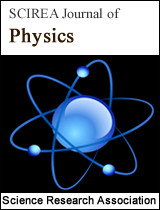Accurate expressions of the optical coefficients, given in n(p)-type degenerate GaAs-crystals, due to the impurity-size effect, and obtained by an improved Forouhi-Bloomer parameterization model (FB-PM)
DOI: 10.54647/physics140552 112 Downloads 12369 Views
Author(s)
Abstract
In the n(p)-type degenerate GaAs-crystals, at low temperature T and high d(a)-density N, our expression for the static dielectric constant, \varepsilon\left(r_{d\left(a\right)}\right), expressed as a function of the donor (acceptor) radius, r_{d\left(a\right)}, and determined by using an effective Bohr model, as that investigated in [1,2], suggests that, for an increasing r_{d\left(a\right)}, due to such the impurity size effect, \varepsilon\left(r_{d\left(a\right)}\right) decreases, affecting strongly the critical d(a)-density in the metal-insulator transition (MIT), N_{CDn(CDp)}(r_{d(a)}), determined by Eq. (3), and its values are reported in Table 1, and also our accurate expressions for optical coefficients, obtained in Equations (24, 25, 28, 29), and their numerical results are given in Tables 2-6. Furthermore, one notes that, as observed in Table 3c, our obtained results of those optical coefficients are found to be more accurate than the corresponding ones, obtained from the FB-PM [11], suggesting thus that the present model, used here to study the optical properties of the n(p)-type degenerate GaAs-crystals, is a good improved FB-PM.
Keywords
Effects of the impurity-size and heavy doping; effective autocorrelation function for potential fluctuations; optical coefficients; critical photon energy
Cite this paper
H. Van Cong,
Accurate expressions of the optical coefficients, given in n(p)-type degenerate GaAs-crystals, due to the impurity-size effect, and obtained by an improved Forouhi-Bloomer parameterization model (FB-PM)
, SCIREA Journal of Physics.
Volume 8, Issue 3, June 2023 | PP. 198-222.
10.54647/physics140552
References
| [ 1 ] | H. Van Cong, “ Accurate expressions for optical coefficients, due to the impurity-size effect, and obtained in n(p)-type degenerate Si-crystals, taking into account their correct asymptotic behavior, as the photon energy E , “SCIREA J. Phys., vol.8, pp. 172-197 (2023). |
| [ 2 ] | H. Van Cong, “New dielectric constant, due to the impurity size effect, and determined by an effective Bohr model, affecting strongly the Mott criterion in the metal-insulator transition and the optical band gap in degenerate (Si, GaAs, InP)-semiconductors, “SCIREA J. Phys., vol.7, pp. 221-234 (2022); H. Van Cong et al., “Size effect on different impurity levels in semiconductors,” Solid State Communications, vol. 49, pp. 697-699(1984); H. Van Cong, K. C. Ho-Huynh Thi, et al., “30.76%(42.73%)-New limiting highest efficiencies obtained in the crystalline GaAs junction solar cells at T=300 K, due to the effects of heavy (low) doping and impurity size,” SCIREA J. Phys., vol.7, pp. 180-199 (2022). |
| [ 3 ] | H. Van Cong, “Effects of donor size and heavy doping on optical, electrical and thermoelectric properties of various degenerate donor-silicon systems at low temperatures,” American Journal of Modern Physics, vol. 7, pp. 136-165 (2018). |
| [ 4 ] | H. Van Cong et al., “A simple accurate expression of the reduced Fermi energy for any reduced carrier density. J. Appl. Phys., vol. 73, pp. 1545-15463, 1993; H. Van Cong and B. Doan Khanh, “Simple accurate general expression of the Fermi-Dirac integral and for j> -1,” Solid-State Electron., vol. 35, pp. 949-951(1992); H. Van Cong, “New series representation of Fermi-Dirac integral for arbitrary j> -1, and its effect on for integer j,” Solid-State Electron., vol. 34, pp. 489-492 (1991). |
| [ 5 ] | C. Kittel, “Introduction to Solid State Physics, pp. 84-100. Wiley, New York (1976). |
| [ 6 ] | M. A. Green, “Intrinsic concentration, effective density of states, and effective mass in silicon,” J. Appl. Phys., vol. 67, 2944-2954 (1990). |
| [ 7 ] | H. Van Cong et al., “Optical bandgap in various impurity-Si systems from the metal-insulator transition study,” Physica B, vol. 436, pp. 130-139, 2014; H. Stupp et al., Phys. Rev. Lett., vol. 71, p. 2634 (1993); P. Dai et al., Phys. Rev. B, vol. 45, p. 3984 (1992). |
| [ 8 ] | J. Wagner and J. A. del Alamo, J. Appl. Phys., vol. 63, 425-429 (1988). |
| [ 9 ] | D. E. Aspnes, A. A. Studna, “Dielectric functions and optical parameters of Si, Se, GaP, GaAs, GaSb, InP, InAs, and InSb from 1.5 to 6.0 eV”, Phys. Rev. B, vol. 27, 985-1009 (1983). |
| [ 10 ] | L. Ding, et al., “Optical properties of silicon nanocrystals embedded in a matrix”, Phys. Rev. B, vol. 72, 125419 (2005). |
| [ 11 ] | A. R. Forouhi, I. Bloomer, “Optical properties of crystalline semiconductors and dielectrics”, Phys. Rev., vol. 38, 1865-1874 (1988). |
| [ 12 ] | G. E. Jr. Jellison, F. A. Modine, “Parameterization of the optical functions of amorphous materials in the inter-band region”, Appl. Phys. Lett., vol. 69, 371-373 (1996). |

